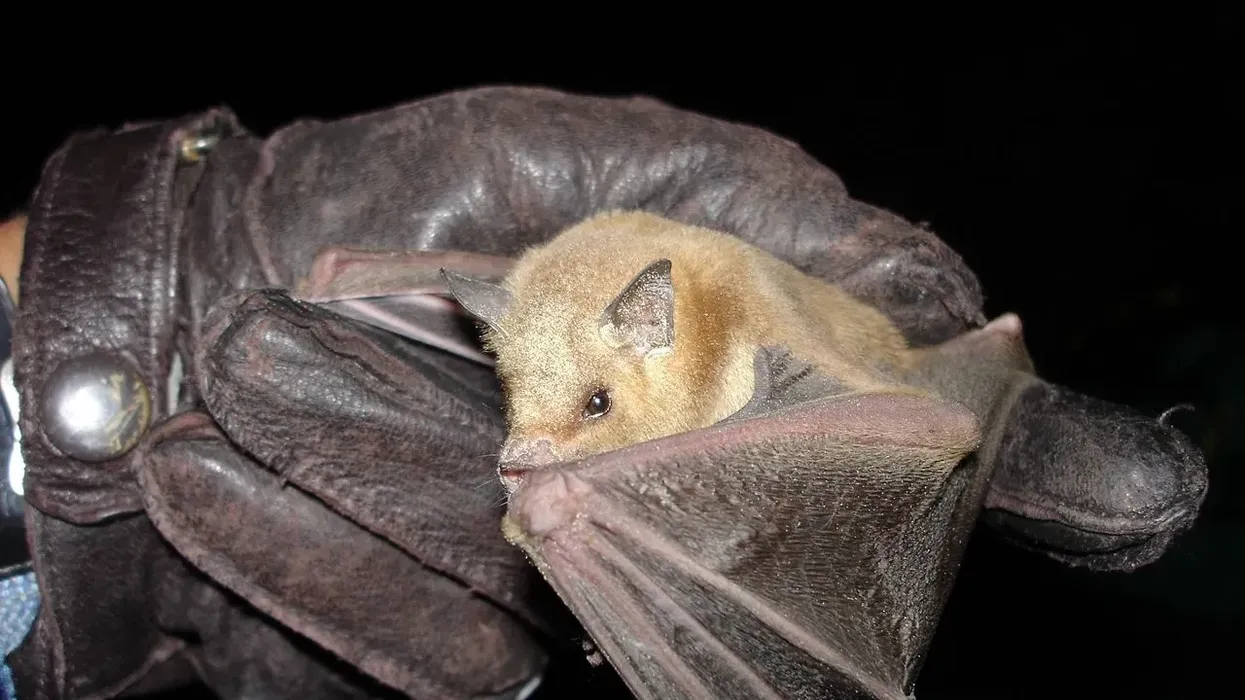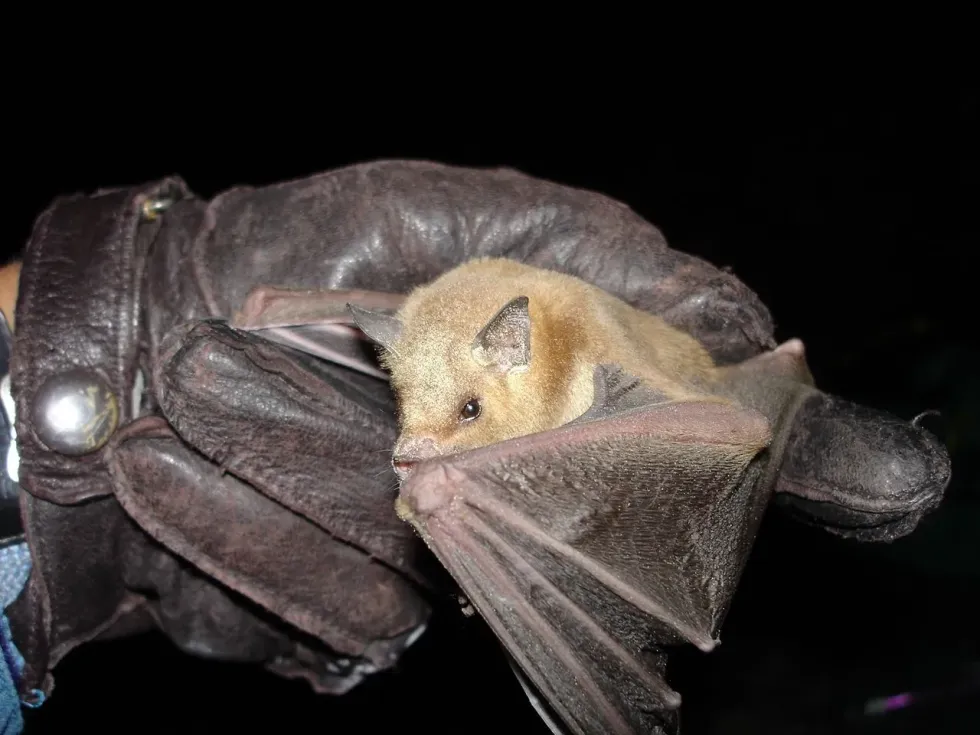A long-nosed bat is a broad group of new world migratory bats that are endemic to North America. This group of bats is subdivided into few species, all of which belong to the genus Leptonycteris.
These species are, namely, lesser long-nosed bat (Leptonycteris yerbabuenae), also known as Sanborn's long-nosed bat, greater long-nosed bat, also known as Mexican long-nosed bat (Leptonycteris nivalis), and southern long-nosed bat (Leptonycteris curasoae).
The lesser long-nosed bat is sometimes referred to as Mexican long-nosed bat.
However, this name is better avoided for the lesser one since the greater long-nosed bats are also known by the same name. The long-nosed bats play a major role as pollinators of flowers in the ecosystem that helps in the growth of plants like agaves and cacti.
The lesser long-nosed bat is the most recognized bat species under the genus Leptonycteris. All the other species of long-nosed bats were listed as Endangered species under the Endangered Species Act by the U.S. Fish and Wildlife service.
However, because of their fast recovery, the lesser one was removed from the list of endangered species by the U.S. Fish and Wildlife service. To know more about the species of long-nosed bat, keep on reading these facts.
For similar content, check out these fruit bat facts and megabat facts too.
Long-Nosed Bat Interesting Facts
What type of animal is a long-nosed bat?
A long-nosed bat is a native bat of North America. The lesser long-nosed bat is the representative species of the long-nosed bats.
What class of animal does a long-nosed bat belong to?
All the species of warm-blooded long-nosed bat of the Phyllostomidae family belong to the class of mammals or Mammalia.
How many long-nosed bats are there in the world?
A long-nosed bat is generally uncommon to the human eyes. Both the lesser and greater ones cover a large extent in southwestern Mexico; however, they have become endangered across much of the range.
The effect of population degradation was much higher for the Mexican long-nosed bat (Leptonycteris nivalis) than the lesser long-nosed bats. They faced certain threats like depletion of their primary food source plants like agaves or cacti and destruction of their roost habitat in the wild.
The bat used to have large areas of roosting sites across Mexico and the United States. The population of these roosts has severely become endangered.
For example, in 1967, a roosting site in Nuevo Leon of Mexico had a ceiling covered with baby bats, but by 1983, there was only a single Mexican long-nosed bat present there.
They also disappeared from another roost of Nuevo Leon in 1983, which used to consist of thousands of bats once. Following their steep decline, Leptonycteris nivalis joined the list of endangered species by the U.S.
Fish and Wildlife Service in 1988 with their relative, the lesser long-nosed bat. However, due to the rapid recovery of the latter species, they were removed from the Endangered Species Act.
Within 40 years, their population grew from 1,000 in 14 sites to 200,000 in 75 known locations. Additionally, the southern long-nosed bats are common during their migratory seasons.
Where does a long-nosed bat live?
Different species are found in different parts of North America like the lesser long-nosed bat inhabit southwestern New Mexico while the Mexican long-nosed bat primarily inhabits central new Mexico. The range of the southern long-nosed bats extends from southwest North America to the north of South America.
The northern range of the lesser long-nosed bat extends up to Arizona, New Mexico, and southern California. The Mexican long-nosed bat lives in southern Texas, New Mexico, and southeast Arizona only from June to August.
For the rest of the year, these bats occupy central Mexico and are found up to Guatemala. The northernmost range of the southern long-nosed bats extends up to southern Arizona.
What is a long-nosed bat's habitat?
The long-nosed bat prefers to live in dry and semi-arid regions, including desert scrub, dry forest, pine forest, and coniferous woodlands. They stay inside dark places in the day and only come out during the night.
The bats migrate in the night in search of food, following night-blooming flowers and plants like cacti and agaves. They roost in caves during the day and sometimes even at night when they have sufficient food like plants and flowers in their cave.
Who does long-nosed bat live with?
Long-nosed bats live together inside caves or mines, forming colonies. The colonies consist of thousands of males, females, and juveniles. Sometimes female-only colonies with their babies are also found while the males are likely to join temporary roosts.
How long does a long-nosed bat live?
The southern long-nosed bat has the highest lifespan and can live up to 30 years of age. The lesser and greater long-nosed bats (Leptonycteris nivalis), on the other hand, can live a life up to 10-20 years.
How do they reproduce?
In lesser long-nosed bats, the breeding season comes twice a year. These birds that migrate to the northern states mate between November and December, while those in the south mate between May to June.
The species of southern and Mexican long-nosed bat (Leptonycteris nivalis) also mates along with the northern lesser long-nosed bats in November and December. It gives birth around May, and during this period, they either migrate to northern Mexico or the southwestern United States.
Maternity caves are also found in South America, where the southern long-nosed bat migrate to give birth.
Males are generally non-migratory, so the pups are nursed only by the females. In the northern range, females form colonies of all lactating females and stay there until the baby is born.
In the lesser long-nosed bats, a single pup is born after a gestation period of six months. The pup can fly after a month.
What is their conservation status?
The conservation status varies according to the availability of the different types of long-nosed bats. The lesser long-nosed bat is listed as Near Threatened in the IUCN Red List, while the Mexican long-nosed bat is listed as Endangered.
The southern long-nosed bats are classified as vulnerable species.
The lesser long-nosed bats used to be endangered, but recently they showed high recovery rates, and their population increased a lot. However, they are still facing significant threats in the wild, like the vandalism of their roosting site and the destruction of their habitats.
Fortunately, these disturbances have not affected the species majorly yet. The Mexican long-nosed bat or Leptonycteris nivalis faces these similar threats along with the threat of food loss because of human exploitation of plants like agaves and cacti.
Previously, a large number of these bats used to populate the caves of central Mexico, but at present, only a few scattered colonies are found.
The effects of destruction and degradation of the bat habitats in the wild have also started to affect the southern population. They do not have any known predators.
Long-Nosed Bat Fun Facts
What does a long-nosed bat look like?

Long-nosed bats are named after their long nose or snout. The front of the snout forms a triangular leaf-nosed structure. They have small bodies, and the fur looks yellow-brown on the upper side with brown underparts. The long tongue and reduced teeth help them to feed on nectar.
How cute are they?
The cuteness of a bat is subjective as they are seen as wild creatures.
How do they communicate?
Communication occurs by touch, especially by nose-nose contact of the mother with its baby, echoes, and by smell.
How big is a long-nosed bat?
The average length of all species of long-nosed bat ranges between 2-3.75 in (5.08-9.5 cm). In comparison, the greater mouse-eared bat is similar in size, while the ghost bat is slightly bigger.
How fast can a long-nosed bat fly?
The lesser long-nosed bat can fly up to a speed of 14 mph (22.5 kph). They are thought to be faster than vampire bats.
How much does a long-nosed bat weigh?
The weight of a long-nosed bat ranges between 0.63-1.05 oz (18-30 g).
What are the male and female names of the species?
The male and female species of bats do not have any specific name.
What would you call a baby long-nosed bat?
A baby bat is called a pup.
What do they eat?
These bats move from one plant to another plant, feeding on the nectar of a flower. Apart from that they also feed on other plant matters like fruit, pollen of a flower, and flower. While nursing, they mostly feed on a flower.
Are they dangerous?
They remain absent from human habitations, therefore, are not much threat to humanity.
Would they make a good pet?
No, bats, in general, do not make good pets.
Did you know...
The length of the tongue of the long-nosed bat is similar to the length of its body.
Is a long-nosed bat a herbivore?
The species of long-nosed bat are strict herbivores that feed only on plant matters like fruit and nectar from flowers. The most famous plants on which they feed are agaves, saguaro, cacti, and bobcats.
Why is the lesser long-nosed bat important?
The long tongue of the lesser long-nosed bats makes them important pollinators for nectar plants by feeding on them. Their feeding habits have contributed to the growth of several plants like agave, organ-pipe cactus, and saguaro.
Here at Kidadl, we have carefully created lots of interesting family-friendly animal facts for everyone to discover! For more relatable content, check out these camel facts and polar bear facts pages.
You can even occupy yourself at home by coloring in one of our free printable long nosed Bats coloring pages.









